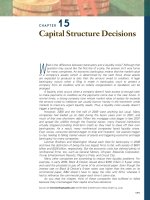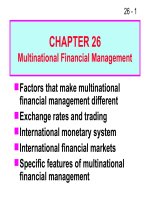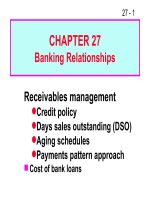FM11 Ch 16 Capital Structure Decisions _The Basics
Bạn đang xem bản rút gọn của tài liệu. Xem và tải ngay bản đầy đủ của tài liệu tại đây (158.83 KB, 62 trang )
16 - 1
Chapter 16: Capital Structure
Decisions: The Basics
Overview and preview of capital structure
effects
Business versus financial risk
The impact of debt on returns
Capital structure theory
Example: Choosing the optimal structure
Setting the capital structure in practice
16 - 2
Basic Definitions
V = value of firm
FCF = free cash flow
WACC = weighted average cost of
capital
r
s
and r
d
are costs of stock and debt
r
e
and w
d
are percentages of the firm
that are financed with stock and
debt.
16 - 3
How can capital structure affect value?
∑
∞
=
+
=
1t
t
t
)WACC1(
FCF
V
(Continued…)
WACC = w
d
(1-T) r
d
+ w
e
r
s
16 - 4
A Preview of Capital Structure Effects
The impact of capital structure on
value depends upon the effect of
debt on:
WACC
FCF
(Continued…)
16 - 5
The Effect of Additional Debt on WACC
Debtholders have a prior claim on
cash flows relative to stockholders.
Debtholders’ “fixed” claim increases
risk of stockholders’ “residual” claim.
Cost of stock, r
s
, goes up.
Firm’s can deduct interest expenses.
Reduces the taxes paid
Frees up more cash for payments to
investors
Reduces after-tax cost of debt
(Continued…)
16 - 6
The Effect on WACC (Continued)
Debt increases risk of bankruptcy
Causes pre-tax cost of debt, r
d
, to
increase
Adding debt increase percent of firm
financed with low-cost debt (w
d
) and
decreases percent financed with
high-cost equity (w
e
)
Net effect on WACC = uncertain.
(Continued…)
16 - 7
The Effect of Additional Debt on FCF
Additional debt increases the
probability of bankruptcy.
Direct costs: Legal fees, “fire” sales,
etc.
Indirect costs: Lost customers,
reduction in productivity of managers
and line workers, reduction in credit
(i.e., accounts payable) offered by
suppliers
(Continued…)
16 - 8
Impact of indirect costs
NOPAT goes down due to lost
customers and drop in productivity
Investment in capital goes up due to
increase in net operating working
capital (accounts payable goes up as
suppliers tighten credit).
(Continued…)
16 - 9
Additional debt can affect the
behavior of managers.
Reductions in agency costs: debt “pre-
commits,” or “bonds,” free cash flow for
use in making interest payments. Thus,
managers are less likely to waste FCF
on perquisites or non-value adding
acquisitions.
Increases in agency costs: debt can
make managers too risk-averse, causing
“underinvestment” in risky but positive
NPV projects.
(Continued…)
16 - 10
Asymmetric Information and Signaling
Managers know the firm’s future prospects
better than investors.
Managers would not issue additional
equity if they thought the current stock
price was less than the true value of the
stock (given their inside information).
Hence, investors often perceive an
additional issuance of stock as a negative
signal, and the stock price falls.
16 - 11
Uncertainty about future pre-tax operating
income (EBIT).
Note that business risk focuses on operating
income, so it ignores financing effects.
What is business risk?
Probability
EBITE(EBIT)0
Low risk
High risk
16 - 12
Factors That Influence Business Risk
Uncertainty about demand (unit sales).
Uncertainty about output prices.
Uncertainty about input costs.
Product and other types of liability.
Degree of operating leverage (DOL).
16 - 13
What is operating leverage, and how
does it affect a firm’s business risk?
Operating leverage is the change in
EBIT caused by a change in quantity
sold.
The higher the proportion of fixed
costs within a firm’s overall cost
structure, the greater the operating
leverage.
(More )
16 - 14
Higher operating leverage leads to
more business risk, because a small
sales decline causes a larger EBIT
decline.
(More )
Sales
$
Rev.
TC
F
Q
BE
Sales
$
Rev.
TC
F
Q
BE
EBIT
}
16 - 15
Operating Breakeven
Q is quantity sold, F is fixed cost, V is
variable cost, TC is total cost, and P
is price per unit.
Operating breakeven = Q
BE
Q
BE
= F / (P – V)
Example: F=$200, P=$15, and V=$10:
Q
BE
= $200 / ($15 – $10) = 40.
(More )
16 - 16
Probability
EBIT
L
Low operating leverage
High operating leverage
EBIT
H
In the typical situation, higher
operating leverage leads to higher
expected EBIT, but also increases risk.
16 - 17
Business Risk versus Financial Risk
Business risk:
Uncertainty in future EBIT.
Depends on business factors such as
competition, operating leverage, etc.
Financial risk:
Additional business risk concentrated on
common stockholders when financial leverage
is used.
Depends on the amount of debt and preferred
stock financing.
16 - 18
Firm U Firm L
No debt $10,000 of 12% debt
$20,000 in assets $20,000 in assets
40% tax rate 40% tax rate
Consider Two Hypothetical Firms
Both firms have same operating
leverage, business risk, and EBIT of
$3,000. They differ only with respect to
use of debt.
16 - 19
Impact of Leverage on Returns
EBIT $3,000 $3,000
Interest 0 1,200
EBT $3,000 $1,800
Taxes (40%) 1 ,200 720
NI $1,800 $1,080
ROE 9.0% 10.8%
Firm U Firm L
16 - 20
Why does leveraging increase return?
More EBIT goes to investors in Firm L.
Total dollars paid to investors:
•
U: NI = $1,800.
•
L: NI + Int = $1,080 + $1,200 = $2,280.
Taxes paid:
•
U: $1,200; L: $720.
Equity $ proportionally lower than NI.
16 - 21
Now consider the fact that EBIT is not
known with certainty. What is the
impact of uncertainty on stockholder
profitability and risk for Firm U and
Firm L?
Continued…
16 - 22
Firm U: Unleveraged
Prob. 0.25 0.50 0.25
EBIT $2,000 $3,000 $4,000
Interest 0 0 0
EBT $2,000 $3,000 $4,000
Taxes (40%) 800 1,200 1,600
NI $1,200 $1,800 $2,400
Economy
Bad Avg. Good
16 - 23
Firm L: Leveraged
Prob.* 0.25 0.50 0.25
EBIT* $2,000 $3,000 $4,000
Interest 1,200 1,200 1,200
EBT $ 800 $1,800 $2,800
Taxes (40%) 320 720 1,120
NI $ 480 $1,080 $1,680
*Same as for Firm U.
Economy
Bad Avg. Good
16 - 24
Firm U Bad Avg. Good
BEP 10.0% 15.0% 20.0%
ROIC 6.0% 9.0% 12.0%
ROE 6.0% 9.0% 12.0%
TIE n.a. n.a. n.a.
Firm L Bad Avg. Good
BEP 10.0% 15.0% 20.0%
ROIC 6.0% 9.0% 12.0%
ROE 4.8% 10.8% 16.8%
TIE 1.7x 2.5x 3.3x
16 - 25
Profitability Measures:
E(BEP) 15.0% 15.0%
E(ROIC) 9.0% 9.0%
E(ROE) 9.0% 10.8%
Risk Measures:
σ
ROIC
2.12% 2.12%
σ
ROE
2.12% 4.24%
U L









